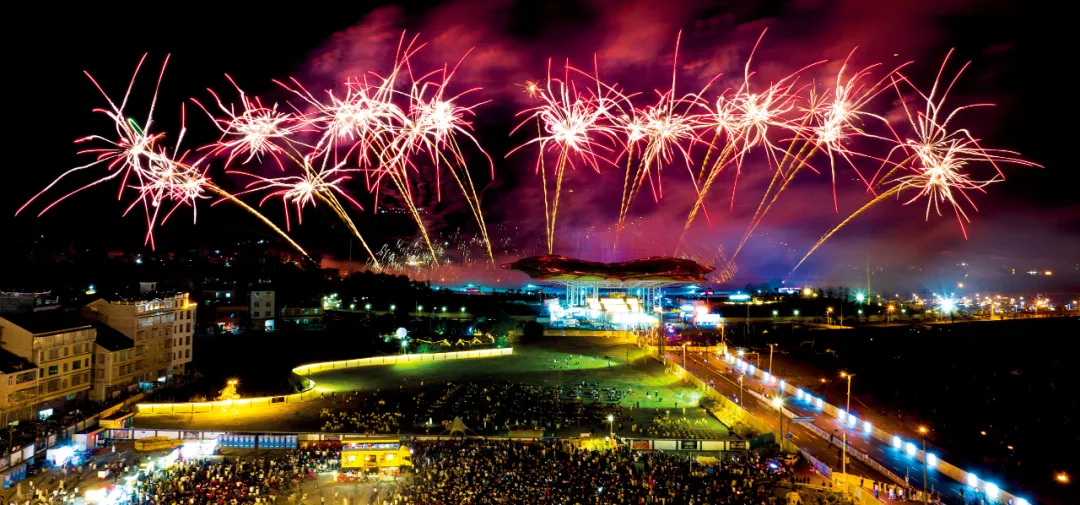For those brief seconds when the "Rainbow Clouds" fireworks bloomed overhead, Lin Zhouzhou felt a profound sense of fulfillment—as if "life was now complete”.
Lin Zhouzhou, who lives in Guangdong, repeatedly saw videos of the "Seven-Colored Auspicious Clouds" at the Liuyang Weekend Fireworks Show on social media platforms. This was unlike any fireworks she had seen before—it wasn't bursting firecrackers, but rather colorful smoke. This was originally a daytime fireworks display, but the designers paired it with white strobe fireworks, which could illuminate the night sky and clearly reflect the colors and shapes of the smoke. At the end of last year, Lin Zhouzhou saw in the preview for the Liuyang fireworks show that the "Seven-Colored Auspicious Clouds" would be performed at the grand finale show on December 28. She and her friends then embarked on a "special forces" style trip, heading directly from Guangdong to Liuyang, Hunan on that very day.
Liuyang is located in eastern Hunan and borders Jiangxi Province. It's the most concentrated area for China's firework industry, earning it the title "Hometown of Chinese Fireworks." Since February 2023, Liuyang has been hosting weekend fireworks shows, attracting a cumulative total of 5 million tourists.
Over the past year, Liuyang fireworks have frequently topped trending searches. People drawn by their reputation "saw fireworks they had never seen before," which were no longer the grand yet monotonous displays of traditional impression. Drones combined with fireworks create a dynamic interplay, expanding the night sky from a two-dimensional canvas to a three-dimensional creative space, imbuing fireworks with infinite freedom and creativity. One netizen exclaimed, "Liuyang fireworks have evolved to the next level.
For many years, however, Liuyang's firework industry was constantly under the pressure of "no-burning policies." Although Liuyang fireworks have experienced a "rebirth," the industry still faces a core question: How can the new firework culture find a balance between environmental protection and safety?

Fireworks show in Liuyang at the end of 2024. Photo/Provided by the interviewee
"Fireworks have evolved to this extent?"
On the evening of December 28 last year, Yi Liang, deputy director of the Liuyang City Firecracker and Fireworks Industry Development Center, was also present at the year-end fireworks spectacular. Just 10 minutes after the show ended, Yi Liang and his team obtained data from the three major telecom operators: over 190,000 spectators were present at and around the site that night, setting a two-year record high.
This wave of "massive traffic" stemmed from the "Gate of Heaven" performance half a month prior. Over 700 drones ascended into the sky, forming a red circle. Accompanied by music, the fireworks mounted on the drones were successively lit, slowly cascading down from the center of the circle like falling tears. The designer of this scene was Huang Weide, chairman of Qingtai Fireworks Company, the company responsible for that night's display. He created it to commemorate his late mother—the circle symbolized the "Gate of Heaven," and the fireworks were his tears of longing for her, "representing love that will never be lost."
The "Gate of Heaven" concept amazed all the spectators. As a result, "Liuyang fireworks unleashed a big move" became the top trending topic on social media, attracting countless viewers both domestically and internationally. Some netizens exclaimed, "This is magic!" and "After years of fireworks bans, have China's fireworks really evolved to this extent?"
Traditional fireworks were simply a combination of sound and light. However, in recent years, with the night sky as a canvas, and integrating various elements like sound, light, electricity, projections, and flames, fireworks have begun to evolve into creative shows.
Take the "Seven-Colored Auspicious Clouds" as an example; even experienced fireworks professionals admit it's an "innovation never before imagined." Dongxin Fireworks is a renowned domestic fireworks display company, best known for setting off the "29 giant footprints" at the opening ceremony of the 2008 Beijing Olympics. The company has also undertaken numerous major domestic and international fireworks display tasks, including the celebrations for the 60th and 70th anniversaries of the founding of the People's Republic of China. Zhong Liang, Deputy General Manager of Dongxin Fireworks, stated in an interview with "China News Weekly" that the "Seven-Colored Auspicious Clouds" concept was initially proposed by the renowned fireworks artist Cai Guo-Qiang. At the time, Dongxin Fireworks and Cai Guo-Qiang were collaborating on developing the fireworks displays for the Beijing Winter Olympics opening and closing ceremonies, but this particular plan was not adopted then.
In December 2023, Cai Guo-Qiang first presented "Mirage" at a fireworks show in his hometown of Quanzhou. This was the prototype for the "Seven-Colored Auspicious Clouds," with some describing the fireworks as "seemingly summoning a cosmic nebula from a distant time and space.
As drone performance technology continues to mature, its combination with fireworks has become increasingly creative and imaginative. During the Liuyang fireworks show for "October 1st" in 2024, a display company upgraded the "Seven-Colored Auspicious Clouds": as the fireworks bloomed in the night sky, drones simultaneously outlined the figure of the Monkey King, recreating the classic scene from the film A Chinese Odyssey where "my true love will come to marry me on a seven-colored auspicious cloud." This quickly spread across social media platforms.
Besides the "Seven-Colored Auspicious Clouds," Lin Zhouzhou's most unforgettable experience was the "Blue Meteor Shower," where drones and fireworks ignited in the sky, causing a blue river of stars to cascade down. "These were fireworks I had never seen in Guangdong," she remarked.
Zhong Liang, the planner behind this grand fireworks show, stated in an interview with "China News Weekly" that fireworks are a traditional industry. "It's hard to create new tricks through pure R&D; to iterate further, you can only layer on creativity." This is also the distinction between Chinese fireworks shows and Japanese Hanabi Taikai (fireworks festivals). Zhong Liang explained that Japanese Hanabi Taikai focus on the ultimate effect of individual fireworks, with very low output but capable of producing giant 48-inch fireworks that are incredibly stunning to watch. Due to safety restrictions, China can only produce up to 12-inch fireworks, but Chinese fireworks have a greater advantage in creativity and choreography.
The Liuyang fireworks show isn't just about the aesthetics of sound, light, and electricity; it's also starting to deeply integrate with storytelling. On January 17th, the Liuyang Sky Theater hosted a special performance: Tomato Novel, a reading platform, collaborated with local fireworks team Huahuo Troupe to promote a popular serialized web novel, I Am Not the God of Theater. They held a novel-themed fireworks show that combined with an audiobook to recreate many classic elements from the story. When the iconic red six of spades playing card from the book was formed by drones in the sky and slowly rotated, the scene gave fans of the novel "goosebumps." Even earlier, the Sky Theater had put on a special fireworks show for the TV series Joy of Life, recreating famous scenes like Fan Xian's wedding and the Chrysanthemum Appreciation Gathering.
"If you only sell products, you can't attract young people."
In Zhong Liang's view, the design capabilities of local fireworks companies in Liuyang have also improved through practice, with the weekend fireworks shows serving as a crucial opportunity.
Liuyang's launch of weekend fireworks shows stemmed from the local need to develop cultural tourism. Liuyang, a relaxed small city, is adjacent to Changsha, a popular "influencer city," but its tourism resources are not concentrated. "The biggest draw is definitely fireworks," Yi Liang told China News Weekly.
Liuyang is one of China's four major fireworks production bases, and approximately 70% of China's exported fireworks come from here. On the other hand, as a traditional industry, the fireworks sector faces pressure to transform. "If we only sell products and stick to the old ways without creativity, we won't be able to attract young people," said Yi Liang.
Changsha has long proven through practice that fireworks shows are highly effective in building a city's brand. Since 2010, fireworks displays were held every Saturday and on major holidays at Juzizhouin Changsha. Media outlets have vividly described how "going to Juzizhouto watch fireworks every week" has become ingrained in the DNA of Changsha residents. Each show attracted over 100,000 visitors, propelling Changsha's transformation into an internet-famous city. However, due to safety and other considerations, the Juzizhoufireworks show in Changsha has been suspended since 2023.
In February 2023, Liuyang "took over" from Changsha, beginning its weekly fireworks and cultural performances. Liuyang boasts 431 firework and firecracker production enterprises and 66 professional fireworks display companies, and has hosted 16 China Liuyang International Fireworks Festivals. The best viewing spot is the Sky Theater, where tickets are priced at just 1 RMB, requiring online reservation. Those who don't secure tickets through the lottery can still come to the area, as the fireworks can be enjoyed from various angles around the theater.
Although fireworks companies cooperate with the government to promote cultural tourism and receive meager subsidies, these subsidies hardly cover costs, making the displays essentially public service acts. Consequently, some companies admitted that in the initial stages, they generally used traditional shell fireworks and aquatic fireworks, keeping the investment per show to a modest 200,000 to 300,000 yuan.
However, the subsequent impact, both in terms of ticketing and social media influence, far exceeded our expectations," Lou Jie, head of publicity for Century Hong Fireworks Factory, a local fireworks company, told China News Weekly. After nearly a year of operation, the Liuyang fireworks show gradually gained widespread popularity. The 2023 New Year's Eve fireworks show attracted 170,000 spectators, almost paralyzing local traffic.
The number of tourists traveling specifically to Liuyang to see fireworks is continuously increasing. Liuyang does not yet have train service, so in the past two years, an unofficial transportation method has emerged between the two locations: tourists arriving in Changsha can simply make a phone call and book a commercial van within half an hour. For about 50 yuan, they can reach Liuyang in just one hour.
The "Gate of Heaven" concept further boosted the recognition of Liuyang fireworks. Yi Liang told China News Weekly that before this, the online reservation count for each fireworks show was around 300,000 people. However, for the last two fireworks shows in December last year, the online reservations both exceeded one million.
According to data provided by the Liuyang City Firecracker and Fireworks Industry Development Center, Liuyang has held 94 creative fireworks displays over the past two years, cumulatively driving 15 billion yuan in consumption.
We gradually realized that the weekend fireworks show not only attracts tourists but also serves as a platform for companies to showcase their capabilities," Lou Jie mentioned. Since 2024, fireworks display companies have started to "compete" fiercely on creativity, and their investments have also climbed. In early December, Shijiong received notification that they would be hosting the fireworks show following the "Gate of Heaven." To avoid disappointing the long-distance travelers, their investment exceeded 1 million yuan.
Dongxin Fireworks was in charge of the grand finale fireworks show in 2024, with Zhong Liang serving as the planner. The overall investment for this event also exceeded one million yuan. As the final show of 2024 on the 28th, it carried a New Year's Eve significance. Zhong Liang set the theme as "Starry Rain, New Wishes," drawing inspiration from the idea that "wishes made upon seeing a shooting star are most likely to come true." He used drones equipped with fireworks to recreate a blue meteor shower, allowing the audience to make their wishes for 2025.
The popularity of the weekend fireworks shows has also brought positive feedback to local fireworks companies. In 2024, Liuyang fireworks display companies executed over 1,800 events both domestically and internationally, accounting for over 90% of the national market share. On January 15th, Zhong Liang stated in an interview with China News Weekly that in the past half-month, various local governments, from Heilongjiang to Hainan, and then to Xinjiang, Inner Mongolia, and Shanxi, have actively contacted Dongxin Fireworks, and 10 Lantern Festival display orders have already been confirmed.
Out of the darkest moment
On a regular weekday evening in early January, at a public square in Liuyang, someone lit "Gatling" fireworks. Not far away, across the Liuyang River from the Sky Theater, fireworks companies conduct sample displays for clients every Monday to Friday.
Liuyang's urban area has never restricted the setting off of fireworks and firecrackers. However, outside of Liuyang, nationwide control policies on fireworks displays have consistently constrained the development of Liuyang's fireworks industry.
Zhang Mingfu, Secretary-General of the Liuyang Fireworks and Firecrackers Association in Hunan Province, told China News Weekly that in the 1990s, Liuyang had over 900 fireworks factories, but they mostly operated as small, family-run workshops where fireworks were handcrafted in personal courtyards. For safety, these fireworks factories began reforms, banning manual workshops and undergoing factory-style modernization.
Liuyang's fireworks companies, including both manufacturing and professional display enterprises, have some overlap. The professional display companies were the first to be impacted by policy changes. At the 2008 Beijing Olympics opening ceremony, fireworks displays like the "giant footprints" astonished audiences both domestically and internationally, driving a sustained increase in demand for fireworks in the domestic market. Zhong Juan, General Manager of Dongxin Fireworks, mentioned in an interview that at that time, most of Liuyang fireworks' display clients were government departments.
In late 2012, the Central Eight Provisions were officially implemented, explicitly prohibiting Party and government organs at all levels from using public funds to purchase or give gifts like fireworks and firecrackers during the New Year and Spring Festival. Dongxin's display business sharply contracted, forcing the company to adjust its product structure.
For fireworks manufacturers, the impact of "no-burning policies" was even more profound. The earliest "no-burning policies" in China can be traced back to the 1990s when cities like Guangzhou and Beijing successively banned fireworks displays due to safety and environmental concerns. Around 2005, with growing calls to lift the bans, hundreds of cities across the country successively rescinded their "no-burning policies.
From 2008 to 2015, local fireworks production in Liuyang was on an upward trend. Subsequently, a new wave of "no-burning policies" gradually rolled out. In 2016, Shanghai's inner ring road was completely banned from fireworks. Starting from the 2017 Chinese New Year, all urban areas in cities above county-level in Henan Province enforced bans. From the end of 2017, Beijing's Fifth Ring Road and within became entirely no-fireworks zones. Data from the Ministry of Public Security shows that in 2018, 803 cities at or above county-level nationwide banned fireworks displays.
Fireworks companies often focus on specific markets based on regional characteristics. Hebei, Henan, Shanxi, and Shandong are some of the largest domestic fireworks markets, and restrictions or bans in these areas have had the most direct impact on fireworks companies.
Hu Yichuang, head of the overseas department at Liuyang Happy Fireworks Export Trade Co., Ltd., mentioned in an interview with China News Weekly that in the early days, Happy Fireworks' domestic sales market was primarily concentrated in Henan, Hebei, and Shanxi. Around 2019, as fireworks ban policies in various regions became stricter, the company's domestic sales volume plummeted by 30%–40%.
However, in Lou Jie's view, the entire industry was affected by "no-burning policies" between 2015 and 2019 and began to decline, but it wasn't devastated. Instead, industry competition intensified because "no-burning policies" primarily restricted fireworks displays in urban areas. Fireworks manufacturers then shifted their focus to rural areas or regions that had not yet implemented such restrictions.
Safety in production is also a "tightening noose" around the neck of Liuyang's fireworks industry, intensifying the industry's reshuffle. On December 4, 2019, an explosion at a Liuyang fireworks factory, caused by illegal and non-compliant production, resulted in a tragedy with 13 deaths and 13 injuries. Zhang Mingfu explained that after this accident, the Liuyang municipal government strengthened safety rectification efforts, implementing an exit mechanism for substandard small factories. The government and industry associations raised hundreds of millions of yuan to support businesses in exiting or upgrading and renovating, with "this round of rectification eliminating over 200 enterprises.
An industry insider explained that fireworks companies need to renew their safety production licenses every three years, and each time, they must invest millions of yuan to meet new standards. "Around 2019, the industry was shrouded in pessimism," a Liuyang fireworks professional recalled. At that time, orders were shrinking, the fireworks industry was labeled a "backward traditional industry," and some companies reluctantly accepted government subsidies to exit the industry.
A detail that struck Zhong Juan was that years ago, during her daughter's parent-teacher conference, the teacher asked parents and students to sign a pledge "strictly prohibiting the setting off of fireworks and firecrackers," further reflecting the awkward position of the fireworks industry.
The outbreak of the COVID-19 pandemic in 2020 led to industry stagnation and a sharp reduction in orders, pushing the already controversial Liuyang fireworks industry to its lowest point. Even industry leader Dongxin Fireworks saw its domestic sales and display business shrink by about 60%. In 2020, Liuyang's total fireworks output value dropped to 20.29 billion yuan, a decrease of 3.8 billion yuan from the previous year, reaching its lowest point in recent years.
"An unprecedented golden age."
Starting in November 2022, many regions began to relax fireworks restrictions. In early 2023, areas like Guangdong, Shandong, and Liaoning shifted from outright "prohibition" to "restriction," allowing the public to set off fireworks during specific times and in designated areas. This concentrated, short-term release of demand translated to the production side, as Liuyang fireworks companies entered an "unprecedented golden age"—with demand surging across both display services and the domestic market.
Hu Yichuang recalled that starting in November 2022, the company received dozens of calls daily from wholesalers, and even ordinary consumers, all inquiring if there were fireworks available for sale. Typically, by May each year, distributors across the country would have already placed their orders for the year-end. However, in late 2022, many distributors placed urgent additional orders. Zhong Juan mentioned that at the time, all factories in Liuyang were completely sold out of inventory, with not even scraps left. "Distributors were very accommodating regarding the fireworks' colors and effects; they just wanted to get their hands on any available stock.
The "Gatling" handheld fireworks were the most popular at the time, going viral on social media, with virtually all distributors specifically requesting them. The "Gatling" wasn't a new product; it was essentially a traditional "spitting pearl" type of firework—a product that regularly launches colorful pearls, flowers, and sounds from the same tube, having existed for decades. Producers innovated by combining multiple slender paper tubes, creating a fast-paced, high-intensity discharge effect that resonated with people's desire to release stress.
Orders suddenly exploded, but factories couldn't keep up with production, and even raw material prices started to rise. Hu Yichuang remembers that the price of "Gatlings" changed daily back then; "the ex-factory price was a few tens of yuan per piece, but at the consumer end, distributors were selling them for as high as two or three hundred yuan." Some local fireworks factories that were on the verge of bankruptcy even came back to life by selling "Gatlings."
After the 2023 Chinese New Year, the Liuyang fireworks industry shook off its slump. Almost all manufacturers wanted to seize this rare opportunity, expanding production capacity, hiring staff, and building warehouses. Hu Yichuang recalled that before 2019, many local enterprises struggled to turn a profit, leading to an outflow of workers. In 2023, however, hiring became easier for businesses; "we'd post sales positions, and many people would apply." Even locals who had already switched professions returned to Liuyang to invest in and open fireworks factories.
However, by the end of 2023, fireworks production began to face oversupply. Zhong Juan mentioned that traditional fireworks products were mostly handmade. But in 2023, due to strong market demand for "Gatling" and other pearl-spitting and fountain-style products, many factories transitioned, even introducing mechanized and automated production, significantly increasing output. By the end of 2023, the "Gatling" market was oversupplied; products that originally cost tens of yuan to produce were being sold for an ultra-low price of 9.9 yuan. After the 2024 Chinese New Year, many factories didn't even resume operations, "because their warehouses were full of unsold stock."
Although Liuyang fireworks have experienced a "rebirth," Zhong Juan believes that fireworks are high-risk products. Disorderly market expansion has led to severe homogenization of products and inventory backlogs, which easily creates safety hazards. She suggests that the fireworks industry still needs a certain degree of industry intervention, especially that factories should not arbitrarily change product categories based on market trends. "Product categories can be adjusted in an orderly manner based on the production enterprise's qualifications to prevent some companies from lacking self-positioning, blindly following trends, and engaging in disorderly production."
”Fireworks Hub "Becomes Younger"
Nowadays, if you search for "fireworks" on social media, in addition to astonishing fireworks shows, what's even more eye-catching are some fun "internet-famous fireworks." The most popular recently is undoubtedly the "jellyfish" firework: a cardboard base with ten small fireworks attached to a spinning disc. After lighting
Fireworks, an art form that has evolved over millennia, are gradually shifting away from their traditional grand and distant narratives towards more personal emotions and experiences. The public's perception of fireworks, their application scenarios, and their consumer base are also becoming increasingly geared towards a younger demographic.
Hu Yichuang, born in the 1990s, is a native of Liuyang whose relatives run a fireworks factory. In 2019, after returning from studying in the UK, he began overseeing the company's international fireworks trade. When he first entered the industry, he felt he was stepping into a "sunset industry." However, starting in 2023, he suddenly noticed that the industry was "getting younger." As fireworks increasingly topped trending searches, were discussed and loved by young people, and gained popularity among celebrities and influencers, fireworks became youthful and trendy. "Before, when we went out, people would think, 'You sell firecrackers.' But now, everyone says, 'You sell fireworks.'"
Over the past decade, influenced by "no-burning policies," Liuyang's fireworks industry has also been exploring ways to save itself. The core issue behind these bans is environmental protection; black powder, a crucial raw material for fireworks, contains sulfur, which produces pollutants like sulfur dioxide when burned, and poses safety risks during production and transport. The key to upgrading the fireworks industry lies in innovative breakthroughs in raw materials. Although the Liuyang municipal government has invested tens of millions of yuan over the past decade, collaborating with institutions like Beijing Institute of Technology and Nanjing University of Science and Technology to research and develop low-smoke, sulfur-free new materials, technical challenges have never been fully overcome. Some materials achieve low smoke but cannot balance stability, economic viability, and safety, making widespread adoption difficult.
But change is already happening. On the production side, a direct sign of this shift towards a younger demographic is how retail fireworks packaging is now catering to youthful aesthetic preferences. Both at Century Hong Fireworks and Happy Fireworks, reporters observed that fireworks gift box designs are no longer limited to traditional red. Instead, they incorporate gaming elements or traditional Chinese aesthetics, adopting vibrant colors and even AI-generated art styles for their packaging.
Happy Fireworks, where Hu Yichuang works, specially designed an original IP using a playful orange and green color combination. He mentioned that during the production peak in 2023, many fireworks companies started to prioritize packaging. "We were the clients, but our design director had to sit in their office, buying everyone coffee and bubble tea, just to ensure the design drafts were completed as soon as possible."
On the product front, the popularity of "Gatling" or "Jellyfish" fireworks wasn't a result of deliberate design by manufacturers; for them, these fireworks were already commonplace. Many products became viral sensations due to spontaneous consumer trends. Hu Yichuang showed reporters a recently popular way to play with "fairy wands" online: arranging ten wands into a five-pointed star shape, which, as they burn, gradually form a heart with their light. This video quickly surpassed 1 million views after being posted on their company's Xiaohongshu account.
"It transforms fireworks into a medium for conveying emotions and and feelings," Hu Yichuang analyzed. With the boost from short video platforms, traditional fireworks have been given new emotional value. "These products might only cost a dozen yuan; you can buy a box of fairy wands and replicate it, and it looks great when you film it and post it on social media."
According to data provided by Liuyang City, Liuyang's fireworks achieved a total output value of 50.89 billion yuan in 2023, and exceeded 50.22 billion yuan in 2024. However, interviewed businesses admit that the most significant variable impacting Liuyang fireworks sales remains the "no-burning policy."
Since 2024, some cities have eased their "no-burning policies." Liuzhou in Guangxi, Anshan in Liaoning, and Zhengzhou in Henan, among others, have successively announced that fireworks and firecrackers can be set off in an orderly, time-limited, and restricted manner during the 2025 Spring Festival. However, many cities still maintain their bans. At least six prefecture-level cities in Henan (Xinxiang, Anyang, Hebi, Zhoukou, Jiaozuo, and Shangqiu) have explicitly stated that no unit or individual is permitted to produce, operate, store, transport, or set off fireworks and firecrackers.
Ahead of the 2025 Chinese New Year, the popularity of fireworks shows continued to surge. However, many local businesses in Liuyang also started to adopt a more rational approach. Hu Yichuang observed, "Since 2024, the industry has generally stabilized. Companies are closely monitoring changes in the economic landscape and consumer market, while also considering how to manage inventory pressure."





